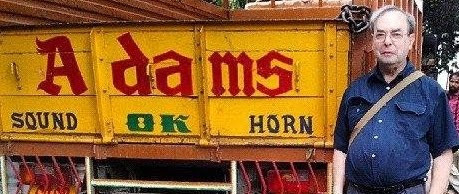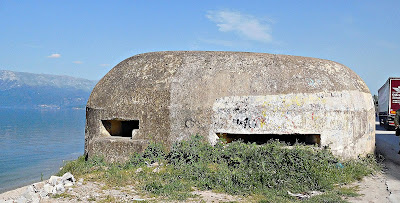Telicherry (Kerala) sketched by Edward Lear in 1874
On
September, the 24th 1874, Mr Edward Lear (1812-1888), who was
staying in Bangalore (now ‘Bengaluru’), wrote in his diary:
“Walked to Orr and Barton’s and got my
photographs…”
Lear
is best known for his nonsense verse, lesser known as an artist. Although never
as successful as his contemporaries (e.g Holman Hunt, Lord Leighton,
Alma-Tadema, Turner, Millais, and Rossetti,) in the 19th century UK art world,
he was a wonderful landscape artist. In addition, he was highly skilled at
depicting flora and fauna (especially birds: he was said to rival Audubon).
Oddly, his talents did not extend to great representations of the human form
except in comical cartoons, at which he excelled.
Restless,
Lear travelled the world in search of the ‘picturesque’. He visited many places,
including Albania, which is what got me interested in him in the first place.
He recorded his travels in sketchbooks, and later transformed some of these
into oil paintings - the medium which he hoped to master - but never really
managed. Lear described his trips in diaries that he later published as travel
journals, his pen producing portraits of the places almost as eloquently as his
fine sketches and watercolours.
Recently,
I discovered that Lear visited India (including Ceylon). He did so at the
invitation of an old friend, Thomas Baring - Lord Northbrook, who had become
the Viceroy of India in 1872. I bought a reasonably priced second-hand copy of
Lear's "Indian Journal", introduced and edited by Ray Murphy
(published in 1953). Unlike his other travel journals (e.g. for Albania,
Greece, Corsica, and Southern Italy), this book contains Lear's actual diary
entries rather than a later polished-up literary version of them.
Lear
describes almost every day of his trip to India, which lasted from November
1873 until January 1875, when sickness and bad back pain forced him and his
Albanian servant Giorgio to end their rambles, which had taken them from the
heights of the Himalayas to the deep south of India and through Ceylon.
The
trip was dogged with problems: logistic, illness, food, and so on. Yet, even on
the worst of days, Lear found something redeeming to write about. Lear enjoyed
Indian 'local colour', but was often less than lukewarm about British colonial
social life. He preferred the ‘really Indian' places to those places favoured
by the British. Many a place where the British liked to spend time relaxing
were loved because, to use Lear's words, because of their:
“un-Indian qualities."
Lear
visited Bangalore twice. His first sojourn was between the 13th of
August 1874 and the 21st of that month. He arrived there on a train
that passed through:
“Arkonam … at the junction of the Bombay-Madras
and Madras-Malabar lines.”
At
this his junction in Tamil Nadu, now known as ‘Arakkonam’, he had to spend a
night in a waiting room. In Bangalore, he took rooms for himself and his
servant in the Cubbon Hotel, which he did not rate highly on arrival. However,
a few days later, he noted:
“The food at this hotel is good, and the
service quiet and unobtrusive…”
Kora
Chandy wrote in “The City Beautiful” by TP Issar (published1988):
“…let me turn to Infantry Road and the present
office of the Commissioner of Police. Some 100 years ago, it was the leading
hotel in Bangalore, called the Cubbon Hotel. The facilities it advertised
included a ball room, ‘complete suites of the bachelor’s apartments’ and
‘carriages on the premises. In the early years of the century the British
Resident purchased this property and his office was located there until 1928…”
In
1911, the Cubbon Hotel still existed, when it was leased by Spencer’s, which
was then in the hands of the Oakshott family.
The Cubbon Hotel was rated along with the (still extant) West End Hotel
as being above average in Murray’s “Handbook for Travellers in India, Burma,
and Ceylon” (10th edition, published 1920). Therefore, the Resident
must have purchased it sometime after 1920. Maya Jayapal writes in her
“Bangalore: roots and beyond” (published in 2014):
“…
the Cubbon Hotel… was constructed in the
prevailing style of colonial architecture, sometimes called Greco-Roman. It is
now the police commissioner’s office…”
A
photograph (see below) in TP Issar’s book confirms Jayapal’s description of the
architecture.
Lear
considered Bangalore:
“…
an odd place, not over beautiful, but
contains three picturesque bits and, I think, one general view. The tall
coco-palms are a chief characteristic, but the queer houses are odd indeed…”
On
the 15th of August, he visited the Lal Bagh gardens, concluding
that:
“…
he had never seen a more beautiful place,
terraces, trellises, etc., not to speak of some wild beasts. Flowers exquisite…
There is something very rural quiet about
this place… walked with Giorgio to
some granite rocks, and a little tank, where I drew till it began to rain, ven
I cum back…”
This
little excerpt exposes Lear’s liberated approach to spelling. I have visited
Lal Bagh often, and have seen its large tank, which contains an island. The
large tank is separated from a smaller one, often filled with waterlilies, by a
causeway. I am not sure about which water feature Lear was writing. Next day, he visited Ulsoor Tank, but
arrived too late to sketch it. The Tank, which is still in existence, is a
veritable lake with several islands in it. Zafar Futehally and Kora Chandy
writing in Issar’s book, noted:
“It extended over an area of 125 acres and
was constructed by Kempegowda II during the second half of the 16th
century.”
It
supplied drinking water to the civilian and military population of Bangalore
until the 20th century.
That
day he praised Bangalore in his diary:
“This station is very extensive and populous,
and seems in some ways the pleasantest I have known in India. A sort of homely quiet pervades everything,
and the air is delightful, ditto flowers. Birds are numerous but make absurd
noises.”
All
over India, Lear remarked on the peculiar birdsong he heard. He left Bangalore
on the 21st of August, heading for Madras.
Lear
returned to Bangalore on the 23rd of September 1874, arriving by
train from Salem. His journey had not been uneventful. Near ‘Cajdoody’ (this is probably modern day
Kadugodi, which is on a railway close to Whitefields, and, relevantly, a couple
of still-extant large bodies of water), a bridge was down. Lear wrote:
“Descending from the carriage, we had to walk
along a narrow edge of clay by the steep side of the embankment; this was …
difficult. … Next, a descent, with a crowd of natives, and still more awkward
pass over loose planks to a boat … ferried across deep and rapid water, the
result of a broken tank which had so swollen the stream as to carry away the
bridge. Then came a hoisting up slippery wooden steps … to the level of the
other train…”
Lear
and Giorgio arrived exhausted in Bangalore on the 23rd of September
1874 after a thirty-minute train journey from the flooded area. It was the
following day that he visited Orr and Barton’s to collect some photographs – of
what he does not say. Throughout his visit to India, Lear bought photographs,
which he might have used to remind him of places that he had seen.
On
my last visit to Bangalore in 2016, I bought some jewellery from Barton’s,
whose extensive shop is within Barton Tower on MG Road. From its earliest days,
it had been a jeweller but it came as news to me that it was also known for its
photography. The 1920 Murray’s guide to India (see above) lists “Barton &
Sons” both as a jeweller and a photographer.
One of the Mr Bartons must have been an exceptional photographer. M
Fazlul Hasan writes in his “Bangalore Through the Centuries” (published 1970)
that when an equestrian statue of Sir Mark Cubbon was unveiled in March 1866,
many photographers rushed forward to ‘snap’ it, but:
“Owing, however, to the fading light and
other difficulties, only two, Major Dixon and Mr Barton, succeeded.”
Bangalore
was not Lear’s last port of call in India. He went on to visit several other
places including Sri Lanka before returning via Kerala to Bombay, and thence
back to Europe. It was noticing that he had visited Barton’s, a shop I know
well, that prompted me to write this piece based on the lesser-known travels of
a well-known cultural figure of the nineteenth century.
READ FASCINATING BOOKS/KINDLES
BY ADAM YAMEY
DISCOVER MORE by clicking: H E R E !



















